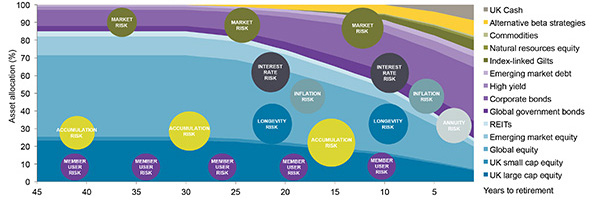The inherent risks in DC default investing
From the blog: UK pensions have faced an avalanche of change over the past few years.
Many of the resulting solutions born from this have revolved around helping scheme participants either avoid or better manage potential pitfalls that could lower their odds of passing the distant and ever-desired ‘retirement finishing line’ with enough money to last them through retirement.
The challenge of getting these often new or unengaged participants on a safe retirement savings path is a complicated one, with a cocktail of investment risks facing them throughout their lifetimes.
Generally, these risks can be categorised as either participant-controlled or participant-experienced.
Participant-controlled risks cover areas that hinge on member behaviour, including accumulation and participant-user risk.
These are usually the largest determinants of whether participants will achieve adequate retirement funding, since even the most innovative defined contribution programs still require members to save enough and invest appropriately.
In contrast, participant-experienced risks are caused by factors largely out of participants’ control, including longevity, the markets, events, inflation, and interest rate risk.
Risks faced by participants over time...
Source: JPMorgan Asset Management, 2015. For illustrative purposes only.
These risks are usually best addressed through participants’ asset allocation choices.
However, the majority of UK DC pension schemes lack the ability to adapt quickly.
More than 85 per cent of UK plan members are enrolled in a default strategy, the most common of which is lifecycle, which mechanistically changes asset allocation over time as participants age.
The challenge of getting these often new or unengaged participants on a safe retirement savings path is a complicated one, with a cocktail of investment risks facing them throughout their lifetimes
When first introduced there was a prevailing expectation for equity investments to deliver an impressive 8-10 per cent a year.
Times have certainly changed.
Across the pond our US cousins have addressed this through the popularity of target date fund default structures – which hold more than $650bn of US pension assets.
TDFs dynamically change asset allocation gradually over time with a focus on member outcomes, rather than simply beating a benchmark.
And because of their single fund structure, TDFs are intuitive to use and easy to monitor, keeping member experience simple and allowing schemes to focus on encouraging better saving behaviours.
Given DC pensions have typically glided members to an annuity purchase – and sales have dropped off a cliff – unlike lifecycle, TDFs can quickly adapt to such a dramatic change in investor behaviour.
Over the course of any individual participant’s working years, all of the risks described above may be experienced to some degree.
Picking a glide path that can flexibly adjust to all of these is essential.
Simon Chinnery is head of UK DC at JPMorgan Asset Management
Most Viewed
- ‘A fundamental point of fairness’: MPs call for action on discretionary increases
- TPR to scrutinise ‘systemically important’ professional trustee firms
- What does Labour have in store for the pensions industry?
- Defining the role of the scheme actuary
- Five themes at the forefront of a sustainable future


